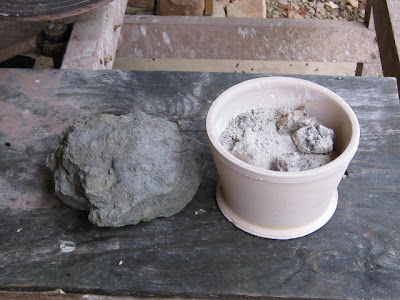Processing Limestone

I have been processing limestone for my upcoming class on Natural Glaze Materials . I found some limestone and put it in this bowl/saggar/container and bisque fired it. When it came out, it looked about the same so I added some water and it proceeded to decompose into this powder.
The bisque is driving off the carbon dioxide and so you have CaO. When you add water it is an exothermic reaction which turns the CaO back into cacium carbonate.
Always amazing,
John Britt
www.johnbrittpottery.com/wks.htm
"All Natural," glaze material!
ReplyDeleteYou HIPPY!
Is there going to be a drum circle at your workshop as well?
;)
Hell yes,
ReplyDeleteAnd we will smoke Jimson Weed in a peace pipe too!
John
Almost...
ReplyDeleteThe calcined limestone is CaO, commonly known as quicklime. Dangerous stuff. :) You got that right.
When slaked, you get hydrated lime, calcium hydroxide. Not so dangerous. Slake it long enough and you get a nice thixotropic putty.
Calcium carbonate is much farther down the timeline. The hydrated lime reacts with the carbon dioxide in the air to bring you back to calcium carbonate. That process takes a relatively long time, though. Couple years.
Back in the day, before Portland cement, all masonry structures were made with lime based mortar. Some 18th century Scottish castles still have unset mortar buried deep in the walls... the carbonation hasn't made it that far. If you're curious to learn more, I'd suggest wikipedia's article on lime mortar... I learned all this by attending a workshop on lime putty mortar at U.S.Heritage group. They are materials geeks there.
Thanks for the correction Julie! I will check it out.
ReplyDeleteJohn